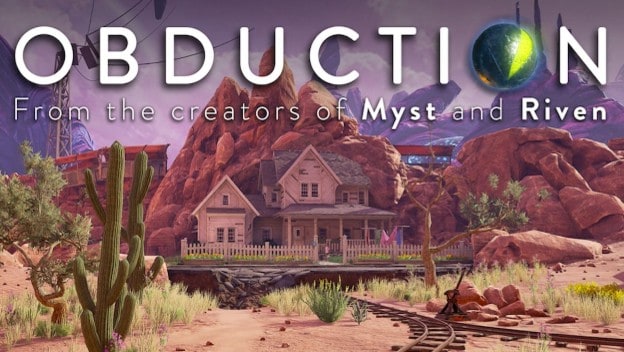Cyan Studios, the same folks that created one of my favorite game series’ in the world ( Myst ), released a brand new game called Obduction at the end of August. The last game Cyan produced was way back in 2005, with Myst V: End of Ages . Needless to say, I am beyond ecstatic that Cyan made a new game after all these years. That said, a few reviewers of the game have claimed that Obduction is the spiritual successor of the Myst series. I think this is true with gameplay, but not very much with the story. Obduction has a different main them from Myst, taking Cyan Studios in a new direction, story-wise.
Obduction begins with a voice recording as you stroll along a lake set in the mountains. The scenery, as usual for Cyan, is breathtaking. But the mystery soon arrives in the form of a bright light. It twists and turns before it comes to rest in front of you. The object spins, growing brighter, until you abruptly find yourself in a desert canyon. As you inspect your surroundings, you happen upon a kind of holographic kiosk. The Mayor of Hunrath welcomes you to his humble abode and directs you to the house with a white picket fence. It all turns out to be oddly devoid of life, however, and it’s up to you to find out why or better yet, escape.
One of the first similarities to Myst I noticed was how the mystery unfolded. In the first Myst you are injected through Atrus’ first book whether you like it or not. Subsequently, you are made to solve the puzzle he left behind for you, so that you may ensure the further safety of the Ages Atrus built. In Obduction , you are abducted by a seed instead of a book, and forced to solve the mystery of the ghost town before you. There’s a lack of choice involved in setting up both stories. The similarities to Myst in story stop here, however.
I would argue that the spirit of the Myst series is restoring artificial worlds. It is the ingenious concept of Rand and Robyn Miller that an entire society be built upon the fact that they can write entire worlds (Ages) into existence. The whole Myst series is dedicated to re-building the empire the D’ni once had. Every broken puzzle is a world that needs healing, that’s why the player is going through and fixing them. It’s not just to see Atrus or Catherine again, or to stop their sons Sirrus and Achenar from writing broken Ages. Thus, it’s easy to see where Obduction is different from the Myst series. Though there is a kind of restoration in Obduction , where the Trees connect various planets together, it is nowhere near the infinite possibilities of Myst . In fact, one big theme in Obduction is undoing the things that humanity does to nature. That’s rather different than restoring a creation of humanity. Therefore, Obduction is not entirely in the spirit of Myst .

The similarities in gameplay however, are extensive and wonderful. Puzzles and clues are laid out in the same open and obtuse manner for the player to find and figure out. All visual cues are usually something to do with the grander puzzle of getting from point A to B and sometimes F just for fun. The puzzles are no less grand in Obduction than they were in Myst , displaying an elaborate set of mechanical wonders for the operation of what seems like a simple task. This is so typical of Myst , it warms my heart to see it again.
As such, Obduction is in some ways the modernized version of Myst , with updated gameplay and graphics. The story is still vastly different, but the spirit of Myst is indeed still strong in the mechanics of the game. With grand puzzles, ever more elaborate machines to operate them, unhelpful NPCs, and obtuse clues, Obduction embodies most, but not all, of Myst ‘s spirit.
